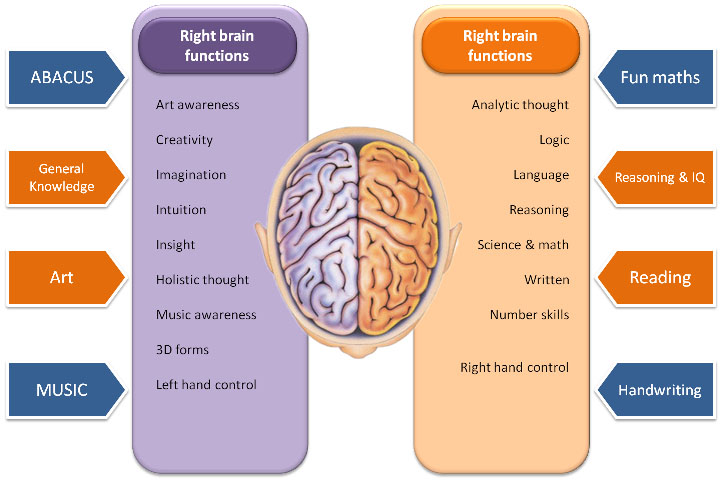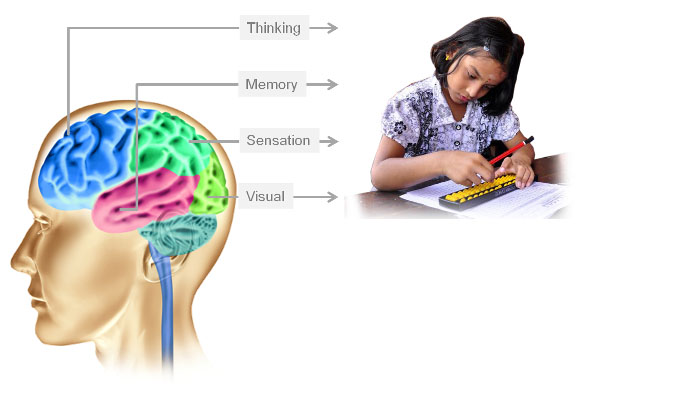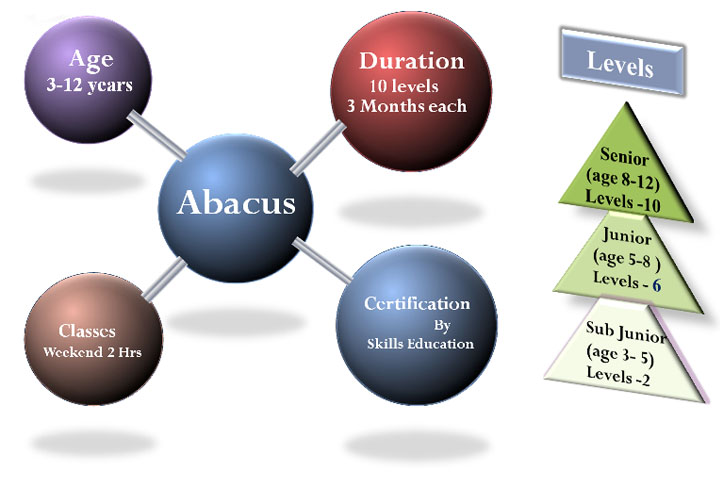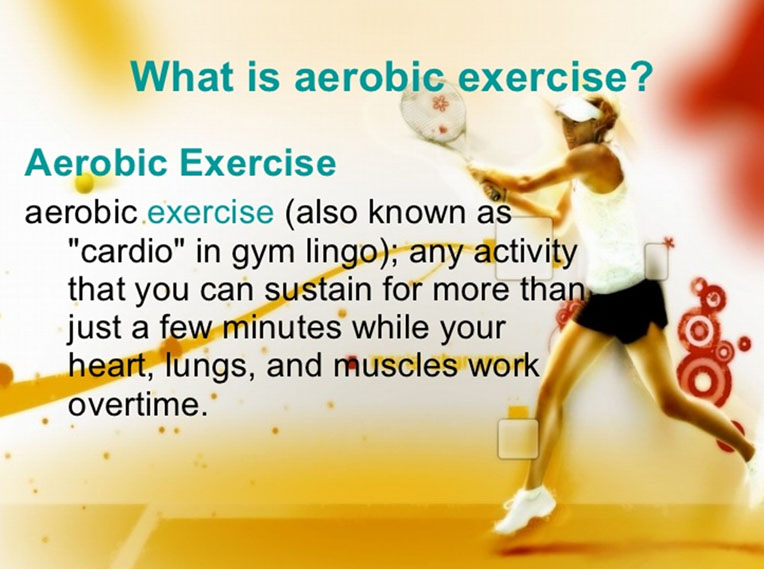- Abacus
- Vedic Maths
- Handwriting
- Chess
- Drawing
- Spoken English
- DMIT
- Mid Brain Focus
- Arts & Crafts
- Yoga
- Carnatic Vocal
- Bharatanatyam
- Tuition Classes
- Zumba Dance
- Aerobics
- Jewellery Making
ABACUS – ACMAS
ACMAS : Abacus concept of mental Arithmetic System
ACMAS Abacus is a scientifically developed & proven program that improves the child's memory, Concentration, Observation, Judgment, Visualization, Imaginative & Creative thinking, Logical, Analytical & Reasoning ability. This is a complete brain development program. This program helps develop a special skill called Mental Arithmetic – An Ability to do Arithmetic calculations like Addition, Subtraction, Multiplication, & Division in the mind without the use of any physical calculating device like Calculator, Abacus etc. Helps your child to solve complex calculations like 3411 x 522 / 225 x 40% + 2421 – 1422 in seconds without pen & paper, calculator or even Abacus.
Know more about brain:

Benefits of ABACUS:
It develops child's
- Concentration
- Confidence
- Analytical skills
- Logical skills

Skills of ACMAS Abacus program:
- Fast calculations
- Whole brain development
- Self confidence
- Self reliant
- Excellent Memory
- Excellent Concentration
- Mental Arithmetic
- Logical, Analytical & Reasoning Abilitiy
- Improved Imagination
ACMAS is skilled in
- Advanced Abacus and Mental Arithmetic Training
- Advanced Course Curriculum
- Excellent, Experienced, Trained Faculty
- Affordable Fee Structure
- World Renowned Trainig Methodology
ACMAS Senior program
- For children aged 9-14years
- This program is of 10 levels
- Each level is for 3 months duration
- The classes will be once a week for 2 hours duration
- Exam and Certificate for each Level
ACMAS Junior Program
- For children aged 5-8 years
- This program is of 6 levels
- Each level is for 3 months duration
- The classes will be once a week for 2 hours duration
- Exam and Certificate for each level
ACMAS Sub Junior Program
- For children aged 4-5 years
- This program is of 2 levels
- Each level is for 6 months duration
- The classes will be twice a week for 1 hour each
- Exam and Certificate for each level
Modus Operandi

For More details, Contact 9941074368
VEDIC MATHS (FUN MATHS)
Vedic mathematics is a list of sixteen basic sūtras, or aphorisms. It is more generally regarded as a set of strategies for calculation. These are said to be creative and useful, and can be applied in a number of ways to calculation methods in arithmetic and algebra, most notably within the education system. A unique technique of calculations with which any mathematical problem can be solved mentally, 10-15 times faster than conventional methods. veda can be translated to mean 'knowledge', Vedic mathematics simply refers to the fact that the sūtras are supposed to present all knowledge of mathematics.
FUNMATHS is a Vedic Maths Program aimed at developing the Mental Arithmetic skill of children aged 10 years & above. This program helps children lose the fear of Mathematics and gain confidence in the subject. It helps the children to develop Problem Solving Ability.
FUNMATHS Benefits:
- Better marks in Mathematics
- Better marks in other subjects
- Improved Self Confidence
- Better Concentration
- Mental Arithmetic skill
- Fast Calculations
- Better Flexibility
- Better Creativity
- Improved Memory
- Greater Mental Agility
FUNMATHS Strengths:
- Specialized program in Maths
- Comprehensive course curriculum
- Highly skilled faculty
FUNMATHS Program Highlights:
- Course is of 4 levels
- Each level is of 3 months duration
- Classes are once a week of 2 hours duration
- Annual Vedic Maths competitions
- Exam and Certificate for each level
For More details, Contact 9941074368
HANDWRITING (WRITEASY)
WRITEASY -Handwriting Improvement Program
Writeasy is a skilled handwriting improvement program which is designed to improve the style and legibility of writing of the young and elders easily. This program is dedicated to maximum legibility with maximum speed. With this program, students develop handwriting that will serve them for the rest of their lives.
WRITEASY Benefits…
- Better Handwriting
- Better Marks
- Improved Confidence
- Excel in Academics
- Better Personality
WRITEASY Program Highlights…
- Course is of 3 levels
- Duration of each level is 3 months
- Classes once or twice a week
- Class duration 1 or 2 hours
- Program completion certificate
WRITEASY Strengths…
- Specialized program in legible writing
- Comprehensive course curriculum
- Highly skilled faculty
- World Renowned Training Methodology
For More details, Contact 9941074368
CHESS

The rules of chess (also known as the laws of chess) are rules governing the play of the game of chess. The rules continued to be slightly modified until the early 19th century, when they reached essentially their current form. The rules also varied somewhat from place to place. Today Fédération Internationale des Échecs (FIDE), also known as the World Chess Organization, sets the standard rules, with slight modifications made by some national organizations for their own purposes. There are variations of the rules for fast chess, correspondence chess, online chess, and chess variants.
Chess is a game played by two people on a chessboard, with sixteen pieces (of six types) for each player. Each type of piece moves in a distinct way. The goal of the game is to checkmate, that is, to threaten the opponent's king with inevitable capture. Games do not necessarily end with checkmate – players often resign if they believe they will lose. In addition, there are several ways that a game can end in a draw.
Besides the basic movement of the pieces, rules also govern the equipment used, the time control, the conduct and ethics of players, accommodations for physically challenged players, the recording of moves using chess notation, as well as provide procedures for resolving irregularities which can occur during a game.
For More details, Contact 9941074368
DRAWING (Free hand drawing)
Best curriculum to develop Free Hand Drawing classes for Kids. This includes Lessons on Coloring, Doll Making & Origami.
Freehand Drawing - Freehand drawing comes with a lot of practice, patience and good observation skills. Mentioned in this article are important tips that will help you to get better at freehand drawing.
How to Draw a Straight Line Freehand - In the world, there are people who can't read, but we never think of those who can't draw. Here's the guide to drawing a line and that's the first step for becoming a true drawing legend.
How to Draw a Circle without a Compass - Freehand Style – Often I have found myself working in the shop needing to draw an arc or circle. Unfortunately I think I may have left my compass in a geometry classroom on the last day of school in 1996. Luckily there are a few tricks to get around this.
'Loosening' Exercises - To further build confidence in your drawing skills there are a number of 'loosening' exercises that can be easily tried alone or in a group. The purpose of these exercises is to free up the artist so that elements, subconscious creativity and 'chance' can shine through. In this way you will learn to make bolder statements, unrestricted by the niggling voice of judgement that often restricts the your freedom of expression.
Sketch : Unique Form of Free Hand Drawing – A Sketch is a free hand drawing made by overlapping lines. It is a fact that with the help of a sketch an artist can develop his mind on various themes and topics.
How to Draw Freehand with Loose Lines

This drawing lessons is to teach you how to sit, where to position your hands, where to look, in order to draw nice loose lines that are important for the freehand style of drawing.
Draw Freely and Loosely Freehand

Learn how to doodle and scribble to help draw freehand…guide your pencil gently, but firmly.
Drawing Exercises to Make You More Creative and Imaginative

Learn how to become more imaginative and creative with the following drawing and illustration exercises for beginners and kids
Exercises for Drawing Evenly Spaced Loose Lines

Exercises to Draw Evenly Spaced Lines and Strokes and for Holding the Pencil Correctly, Freehand.
Cartoonist Warm Up Exercises: Girls' Hair

I think it's especially important to warm up on things you're not good at, this is freehand drawing
Drawing Freehand Lines Confidently

Of course you can. Use a ruler. When you want to draw anything else, freehand drawing is a matter of habit, observation and practice. Seeing line in three dimensional objects is looking at their edges.
Drawing Warm Up Freehand Exercises

It's not about the end result as much, it is about the taking part and creating ideas in art, because everyone has ideas within them and as an artist these need to be expressed through the process of art.
Free Hand Drawing in Two-Point Perspective Video Tutorial

Learn how to draw organic shapes using two-point perspective in this free video art lesson without rulers or tools
Freehand Drawing Will Allow You to Draw Anywhere, and Anything.

Freehand drawing will free you up to go out into the world and draw anything, and anywhere you please.
Freeing Yourself Up Exercise

Accordingly the build up of pressure leads to a build-up of tension in the body and arms resulting in poor posture and restricted movements.
How to Draw People: Warm-Up Exercises Before Drawing

Warming up before drawing is important to loosen up the hands and get your ideas flowing. Complete a few doodles and sketches to warm up with a demonstration from a professional illustrator in this free video on drawing.
A Simple Trick for Drawing a Straight Line Freehand Style

Learn how to draw a straight line without a ruler … a simple trick will help a lot to improve your freehand drawn straight lines. I always had some trouble with drawing a straight line while sketching outdoors. Somewhere I read about this simple "trick" that I want to share here
For More details, Contact 9941074368
SPOKEN ENGLISH
English is language of business and professional communication in India.
Even in academics, most courses in Indian institutes and universities are offered in English, therefore even for students, it becomes extremely essential to have a command over English language that aids them to excel in their academics.
Let us look at some tips on how to improve your English communication:
#1 Forget the fear
The main problem with most students who find it difficult to speak English well is that they lack confidence and they have a fear that they might go wrong and will be laughed at.
But if you do not start practicing English communication how would you know where you are going wrong and where you need to improve. We all make mistakes and the only way to learn is to practice and have others correct us.
#2 Think in English
When communicating in English language, many students tend to think in their mother tongue and speak in English.
If you wish to improve your communication in English then first you need to start thinking in English, i.e., change your language of thought from your mother tongue to English as this reduces the effort of translating your thoughts from your mother tongue to English.
#3 Word power
Improve your vocabulary to improve your communication. Keep a dictionary handy and use it to learn the meaning of a new words that you hear but don't about its meaning.
Make a list of such new words as and when possible and try to use these words when you are communicating in English, this helps you make your language richer.
#4 Use the media
Read English books, newspapers and magazines. Watch English news, TV shows, movies, preferably with subtitles.
The more you hear the more exposure you get to new words to add on to your vocabulary and you get more familiar to the pronunciation and intonation of different words.
Record your own voice and listen to it. This will help you gain confidence and work on your mistakes.
#5 Call a friend
Also try and find a friend who is also interested in improving English so that you can practice together, correct each other and learn together.
Improve your English language skills
Success beyond belief starts with a good understanding of the English language. English language skills are valued by employers, universities and colleges worldwide and are a powerful tool in thousands of careers. Learning English thereby improving your written and spoken English is a great investment in your future.
Prepare for your future, Learn English!
Our New English textbook can give you the confidence and skills you need to communicate effectively in English. We can help you achieve your goals. Increase your future prospects by learning English for your career, for educational purposes, for improved confidence or for fun.
Do you want to sound 'more English'?
Do you want to sound 'more English'? Perhaps like your favourite actor or singer? Then Learn English here!

The good news is you can! But not without lots of careful listening and pronunciation practice. So, if you want to put in the work, here's how you can improve your pronunciation:
- Choose a short scene from your favourite film, TV programme, or interview with your favourite actor or singer. Download it and save it so that you can listen to it many times.
- Listen to your chosen scene and write down the transcript word by word. If your chosen scene is from a film or a TV programme, you might be lucky and find it already transcribed on the Internet.
- Listen to the same scene again and notice the pauses. Whenever the speakers make a pause, use / / to mark their pauses. For example: Life is like a box of chocolates,/you never know what you're going to get .
- Listen to the same scene again. This time notice the stressed words, and underline them. For example: Life is like a box of chocolates,/you never know what you're going to get.
- Listen to the same scene again and pay attention to the intonation – if the speakers' voices go up, down, up and down or down and up! Mark the intonation using arrows.
- Now listen and repeat line by line. Not once or twice, but until you feel you sound exactly like the speakers in your scene.

Courses Offered : English Grammar | Spoken English | Workshops on English
These courses are available at a range of levels and are structured to improve your overall English competency across the four skills - speaking, listening, reading and writing. You will also develop your ability to use English grammar, pronunciation and vocabulary with confidence and accuracy.
- Our communicative approach ensures that you will be able to activate your English.
- A limited class size provides plenty of opportunity to practise.
- We use the latest course books and digital resources.
- You will receive quality feedback from our expert teachers.
- We will raise awareness of common errors which influence your communication.
- You will improve your ability to learn independently during and after the course.
- Measure your progress with continuous assessment.
Learn English through games, puzzles, songs rhymes, stories and other activities:
We run a 30-hour Summer School courses for young learners between the ages of 8 and 15 years.
All courses provide theme based activities designed to develop language skills (speaking, writing, reading and listening), vocabulary and pronunciation.
Project work is fun and different to the normal school routine and encourages confidence, creativity, communication and team-working skills.
The theme of our 2015 project is Go Green!
How you learn
Face-to-Face | Online Virtual Classroom | Guided online learning
Communicate effectively in public speaking and group discussions
Would you like to take an English language workshop that focuses on developing your speaking skills? Our Smart Speaking workshop focuses on enhancing your communication skills for use in public speaking, group discussions and everyday interactions. This workshop makes it possible for you to speak more effectively in English in a wide range of situations.
Learn to write feature articles, screenplays, short stories and travel writing
Are you a scribbler, a secret diarist or a would-be journalist? Do you write professionally or as a hobby? Looking for fellow enthusiasts to share your ideas with and get feedback on your own work? Then look no further. Our Creative Writing course offers the opportunity to meet like-minded people and learn a variety of techniques to improve your writing process and enhance creativity.
The course content covers fiction, short stories, poetry and dialogue. You can also learn how to write feature articles, screenplays, news reports, travel writing etc. The syllabus is specifically designed for those who wish to write creatively but appropriate guidance is what they are lacking to realise their dreams.
Our experienced teachers understand this and will help guide you towards finding your unique writer's voice. Once you join our Creative Writing course, you will realise that vibrant classrooms and interactive sessions are exactly what you need to begin your journey as a writer. The course is, however, not aimed at those wishing to improve their academic or technical writing.
Phonics
Phonics is the study of the production and perception of speech sounds. During your study of Phonics, you will begin to think about the process of speech. You will learn how speech is formulated by the speech organs. You also will learn how individual speech sounds are created and how they are combined during the speech process to form syllables and words. You will need to learn to listento the speech patterns of words and sentences to become familiar with the sounds of speech that comprise spoken language. A large part of any course in Phonics also involves how speech sounds are transcribed, or written. There- fore, you also will be learning a new alphabet that will enable you to transcribe speech sounds.
The idea of studying speech sounds may be an odd idea to understand at first. We generally think about words in terms of how they appear in print or how they are spelled. We usually do not take the time to stop and think about how words are spoken and how spoken words sound to a listener. Look at the word"phone"for a moment. What comes to mind? You might consider the fact that it contains the five letters: p-h-o-n-e. Or you might think of its definition. You probably did not say to yourself that there are only three speech sounds in the word ("f"-"o"-"n"). The reason you do not consider the sound patterns of words when reading is simple - it is not something you do daily. Nor is it some- thing you were taught to do. In fact, talking about the sound patterns of words and being able to transcribe them is an arduous task; it requires considerable practice.
As you soon will find out, the way you believe a word sounds may not be the way it sounds at all. First, it is difficult to forget our notions of how a word is spelled. Second, our conception of how a word sounds is usually wrong.
For More details, Contact 9941074368
D.M.I.T.
INTRODUCTION OF DERMATOGLYPHICS
Dermatoglyphics is the study of ridged skin patterns (also known as dermatoglyphs) which can be found on fingers, palms, toes and soles. These patterns are formed from the external ectoderm and usually occur during the fetal development stage, 13 to 19 weeks after fertilization. Through research, geneticists have proven that dermatoglyph formations are controlled by chromosomes, and the patterns are influenced by polygenetic inheritance. These genes do not exhibit dominance, and they are very resistant to acquired changes from the environment. Using their morphologies, the patterns can be classified into two categories, namely “ridges” and “furrows”. During the seventh week of pregnancy, vertical thumb creases (thenar contours) begins to appear on the palm of the embryo. Two weeks later, remote and proximal horizontal creases (hypothenar contours) begin to form.
Hirsch and Schweicher discovered that prior to the formation of dermatoglyphs, the dermal nerves and blood vessels are arranged in an orderly fashion. This led them to believe that the nervous and vascular systems determine the formation of dermatoglyphs. Consequently, they also established the correlation between the dermatoglyphic patterns and one’s personalities.
From the anatomical point of view, the human hands dominate all other organs in terms of relative importance. This is why the brain dedicates the majority of approximately two hundred million nerve endings to the hands. In other words, the hands are sources of physiological and psychological information waiting to be tapped, hence the increasing importance in the field of dermatoglyphics.
 |
 |
 |
D.M.I.T. reveals following information about a child or adult :
1. Intrinsic Potential
2. Multiple Intelligence Distribution
3. Dominant & Preferred Learning Style
4. Learning Communication Character
5. Allocations of various abilities
6. Psychological & Planning capability
7. Learning Sensitivity
8. Innate - Work Management Style
We help parents to understand the inborn intelligence level of their child. After the test, we provide free counselling to parents or applicants about the report. In this, we guide them to choose the activities or careers according to their inborn intelligence. For example, a child having high Linguistic intelligence can learn a foreign language instead of going for dance class.
We are also designing activities for children based on Multiple Intelligence and Learning Styles concepts. Some of them include Foreign language courses, (for age group starting from 5 years), Public speaking Activities, problem solving, Creative thinking, Training your sub conscious mind to be succesful in life etc.
GET TO KNOW DERMATOGLYPHICS
Where do fingerprints come from?
According to medical research, fingerprints are created before birth. They are formed during the fetal development stage between the 13th to 19th prenatal weeks.
Will fingerprints change?
No, our fingerprints are as invariable as they are unique. Between year 1626 and1690, Spanish Dr. Marcello Malphigi pioneered the scientific research on fingerprints. He was also the first Professor or anatomy to utilise the microscope to examine fingerprints and record them. In his research, he discovered that individual fingerprints are unique. Later on, dermatoglyphic experts proofed that fingerprints are not only unique, but invariable as well. Currently, the invariability of fingerprints contributes greatly to criminal investigation. Through fingerprints, law enforcers could identify perpetrators with unequivocal accuracy.
|
What does dermatoglyphics tell us? |
 |
||||||||||||||||||||||||||||||||||||||||||||||||||||||||||||||||||||||||||
|
On the other hand, some practitioners misused dermatoglyphics and conduct fortune-telling instead of proper analysis. This practice is considered a faux pas as dermatoglyphics is based on genetic research instead of baseless predictions. Consumers are therefore reminded to exercise caution should they encounter practitioners with questionable techniques. DERMATOGLYPHICS VS MULTIPLE INTELLIGENCE
|
|||||||||||||||||||||||||||||||||||||||||||||||||||||||||||||||||||||||||||
LEARNING STYLES
|
Individual learning styles and characteristics consist of three factors: New York Saint John University Ken & Rita Dunn conducted research on students’ learning styles. They discovered that about 30% of the students still recalled 75% of the lecture content after a session. To achieve the same retention rate, about 40% of the students need to read through the content (including words and illustrations), about 15% needs physical stimuli and the remaining 15% needs bodily-kinesthetics learning experiences. Therefore, it is inferred that individual learning styles are different. Nevertheless, traditional teaching methods tend to use only one teaching style to cater for all. For students who have visual and auditory learning styles, this method is extremely effective. However, this is at the expense of students with other learning styles. It is recommended that individual learning styles be identified as early as possible. Then, they should be put into an environment which suits their learning styles so that the learning process could be efficient and effective. |
|
|
Dermatoglyphics – Benefits for CHILDREN / STUDENTS / ADULTS:
- Identify his/her inborn talents and weaknesses
- Identify his/her best learning style and characteristics
- Subject/Course/Career selection
- Reduce time and money wastage over irrelevant course and classes
- Develop a person’s confidence
- Improve the relationship between parents and children
- A quality life for a person
ASSESSMENT & PROCEDURE
Procedure for DMI testing:-
1. Learn how DMIT can help you discover your child’s intrinsic potential in a discussion forum organized free of charge by Eazy Day Academy regularly (limited number accepted). You can also visit our Centre for free consultation.
2. You may then register and pay advance amount for fingerprint scanning with the DMI program. The digital scanning procedure will take about 10-15 minutes.
3. You will be contacted within three days to collect your assessment report. This will be followed by a 45 minutes to 1 hour session with our expert counselors for individual counseling and explanation of the report.
4. You are welcome to have another session with our expert counselors should there be any queries.
MID BRAIN ACTIVATION:
Once the ‘MidBrain’ is activated, children will have easy access to both the left and right brain. They will be able to Learn, Read and memorize things in a much faster speed and thus boosting their confidence, interest and concentration in learning.
MidBrain Activation helps in:
- · Super IQ
- · Bring out their hidden human possibilities
- · Speed Learning
- · Enhance well-balanced development of the body and mind
- · Multiple Languages Mastery
- · Superb Intuition
- · Nurture sharp sensitivity
- · Creative Talent
- · Photographic memory
- · Live on the principle of universal love and harmony
- · Contribute to society with a sense of oneness
- · Computer Calculation Speed
- · Enter into the ‘Peak Learning State’
- · Enhancing child’s concentration, memory and level of confidence
CONCEPT:
MidBrain acts like a communication bridge connecting Left Brain and Right Brain
Science behind MidBrain Activation:
MidBrain (Interbrain) has to be awakened by stimulating a hormonal discharge. In the human body, it is the pituitary gland that regulates the hormone secretions and this function has to be awakened. For this, it is necessary to activate the neighboring Pineal Gland. The pineal body secretes two hormones: Melatonin and Serotonin.
The secretion of Melatonin increases in the dark and decreases when it is bright..
Human Brain Wave:
- Gamma : Ideas, language and memory processing, and learning.
- Beta : Alert, Busy, Active. Most adult in beta waves.
- Alpha : Relax (access intuition/genius condition/brain optimum).
- Theta : Deep meditation (almost sleep). Often feel spiritual experiences.
- Delta : Sleep.
Genius condition doesn't refer to Intelligent Quotient only but also Emotional Quotient , Creativity Quotient and Spiritual Quotient.
During the MidBrain Activation child learns how to enter the condition of meditative genuineness in order to be able to SEE with eyes closed. The term "genius" here doesn't mean someone with IQ above 130, rather, it's the condition that if we are able to decrease the brain wave down to alpha-theta, our brain will function optimally. When the brain functions optimally, all human senses will be in their top performances including the capability of intuition, so that a child is able to do activities with his/her eyes closed.
We should know that, if your brain is able to be trained to enter this condition, you will even be able to do speed reading (reading a book, 1 page in 1 second), even more: with the book positioned upside down! So, the capability of blindfold, speed reading, faster memorization, and better concentration can be achieved if our brain successfully enters the genius condition (alpha-theta waves).
What makes a child have MidBrain Activation ability is the active intuition. What is intuition? Intuition is the man's capability to obtain perception regarding all matters instantly/real timely or "the capability to think without thinking". Another definition for intuition provided in Wikipedia.org site is: Intuition is a combination of historical (empirical) data, deep and heightened observation and an ability to cut through the thickness of surface reality. Intuition is like a slow motion machine that captures data instantaneously and hits you like a ton of bricks. Intuition is knowing, sensing that is beyond the conscious understanding - a gut feeling. Intuition is not pseudo-science. - Abella Arthur
How do we know the ‘MidBrain’ of your child is activated?
To be able to ‘See’ and ‘Read’ blind-folded, it shows and proves that your child’s Midbrain function is awakened (activated). Once MidBrain is awakened, your child’s hidden potential will be unleashed one by one. If your brain is able to be trained to enter this condition, you will even be able to do speed reading (reading a book, 1 page in 1 second), even more: with the book positioned upside down! So, the capability of blindfold, speed reading, faster memorization, and better concentration can be achieved if our brain successfully enters the genius condition.
FAQ:
Q. How old should my child be for the EA Course?
A. The Course works best on 5-15 year olds. Older than this age in other countries have benefitted greatly too.
Q. If my child is already talented, will the Courses still be useful?
A. Scientific research has proven that even a person as intelligent as Albert Einstein does not use more than 10% of his or her brain. The EA Course has the potential to transform children with average intelligence into highly intelligent individuals, and capable children into outstanding kids. The workshop aims not only at improving the IQ of children, but also their EQ. It also helps a child achieve emotional balance.
Q. Does the EA Course have any theoretical foundation?
A. Yes, renowned scientists across the world have come up with supporting theories. Much more equipment is available these days to help measure and test brainwaves.
Q. Why are the children blindfolded?
A. During the EA Course, the initial aim of blindfolding is to enhance a child's concentration. We try to achieve this by disabling the sense of sight on which most people heavily depend. Blindfolding also helps sharpen the other senses.
Q. If my child cannot "see" after being blindfolded, does that mean the course has failed?
A. Despite the EA Course, a few students have been unable to "see" after being blindfolded. This won't last for long. Note that the technology also enhances the memory, concentration and intellect faculties. All that these children need to do is PRACTICE and they would soon reap the benefits of the Course.
Q. Do students need to practice the technique blindfolded for the rest of their lives?
A. Immediately after the Course, blindfolding is essential to increase a student's concentration. As time progresses and the students' abilities improve, they could opt to close their eyes. Their concentration and other mental abilities should eventually improve dramatically. Blindfold practice is mostly required for the first few months following the Course.
Q. Is it true that some blindfolded students can easily see through the gap near their nose?
A. The use of a blindfold is not solely to prevent students from using their eyes. Students should also be encouraged to close their eyes when blindfolded in order to improve their other senses. If you are worried that your child is frequently peeping through a gap, you could add another layer of tissue under the blindfold to plug any gap.
Q. How do a few students identify the colour and number on cards held behind their heads?
A. All students do not acquire this ability. In reality they cannot 'see', but they only 'feel' the colour or writing. That is because their brain works like a radar sending signals to the brain. Many children use their skin to feel and identify a colour and the number on cards.
Q. How should I help my child after the EA Course?
A. A happy heart is your child's destination. You must allow a 3-month period for stabilisation, and during this time the more a child practices the better would be the results.
Q. What should I do during the practice sessions?
A. If your child cannot see when blindfolded, then start with the simplest of colours. If they can see very clearly after being blindfolded, then allow them to try to read a book, write, draw etc. After training, children should be able to see objects that are even farther away. For further stabilisation, you can practice with your child in a dark room. You will eventually not need a blindfold to practice; just train a child to shut his or her eyes.
Q. After the EA Workshop why is my child's performance often unstable when blindfolded?
A. In general, after the Workshop the performance of a child is unsteady for up to 45 days. After that, regular practice leads to stability.
Q. What should I do if I have no time to practice?
A. You do not need special plans for your child's practice. You can practice the blindfolding technique in a car or even while traveling to school.
Q. Are there any medical side-effects to this Course?
A. None whatsoever. After the Course, the right brain (responsible for long-term memory) and other parts of the brain would have improved. There are only advantages, no disadvantages.
Q. How do you know there are no side-effects to your Course?
A. Japan has been conducting similar right-brain development Courses for more than 50 years. This has benefitted thousands of students who have attended similar Courses since 2005. Right brain development has made them happier and smarter.
Q. Why my Child does not improve in his studies after the course?
A. According to the Japanese researchers, the memory increases one million times after the brain activation. Theoretically, a person should show improvement in studies because of the increase in memory and sensory capabilities. However, if a person is not interested in his studies, it is very difficult to improve because he uses his memory for other purposes that he is interested. Parents should find out the root reason for no improvement in studies.
Q. After the midbrain activation, a student can see in the dark. Is it true?
A. Yes, it is possible to read newspaper in the dark! Most animals can see in the dark. Fish can see in the dark. They see by using the brainwaves because their midbrain is active. The animals brain is not damaged because they do not cry like the babies do!
Q. Why are parents not allowed to enter the classroom?
A. Firstly, the students are distracted in the presence of the parents. Secondly, EA has to reserve the copyright and to protect the intellectual property.
Q. What to do in the long term?
A. When a child is stable, it is not necessary to use cards and so on to help him/her to practice. He/she just blindfold and do anything blindfolded.
Q. I never hurt him, but he still refuse to practice!
A. Sometimes rewards are helpful. Some children need to do things in a group. Try to go to the center and practice with the others.
Q. How do I hurt my child unknowingly?
A. Most parents are very blunt and loud. They easily hurt by accusing their child for cheating. If parents are doubtful, they need to solve their doubt rather than accusing him/her. Just gently ask whether their eyes are closed or not rather than accusing him/her of peeping.
Q. Why does my child not like to practice?
A. You need to find out the root problem and solve it. Sometimes parent hurt their child unknowingly.
Q. What to do during the practices?
A. If your child says he/she is not able to see, then try touch, smell or listen to sense the colors on the flashcards. If your child is able to get many right answers, then get him/her to read, copy, draw, coloring etc. Then train your child to use other senses when the dominant (first one that he/she uses to sense the cards blindfolded)sensory is stable.
Q. How to start practicing?
A. The best is to have a secure and relaxing environment. Start off by deep breathing (10 times) because the brain needs a lot of oxygen to be maximized. Then blindfold him/her and start to use the super sensory perception to detect/sense things.
Q. Is this the "third eye" as commonly referred to?
A. No. The ability to detect things by using the brain is different from the third eye. In fact, after the brain activation, a student can have "skin vision." That means he/she can read by touching with the hands or foot. If a person is "hearing dominant" he/she knows the color and number of a card by putting it near to the ear. If a person is "smell dominant" he/she can detect the numbers and colors by smelling.
Q. Tell me, how do you activate the midbrain?
A. EA has a system that is unique and original, invented by the research team after years of research. Games, songs, music and sounds are part of the whole system. There are neither religious nor spiritual activities during the activation - totally natural and scientific. No medication is used. The class is filled with fun and happiness. That's why many children loves to come back to repeat the course.
Q. Is there any bad effect after the brain activation?
A. No bad effect at all. After the brain activation, the brain power has been restored. There is only good effect....no bad effects.
Q. Where is the midbrain, what is the medical name for it?
A. The midbrain is located above the brain stem, at the center of the brain. The medical name for midbrain is DICENPHALON.
There is a GENIUS in every child waiting to be awakened!
The key to activating and unleashing the genius in your child is in our hands.
EA Endeavour to make your children academically Competent, Emotionally Confident and Socially Responsible citizens of tomorrow. And to achieve this, we have to begin now!
“Ordinary Learners become Smart Learners Smart Learners become Outstanding”
What will the child achieve at EA?
- ·Have increased and improved memory
- ·Gain higher self confidence and belief
- ·Have improved learning capability
- ·Have more creative mind
- ·Be more motivated and positive
- ·Have better concentration and focus
- ·Balances right and left brain
- ·Develop blindfold reading abilities
- ·Makes one emotionally stable and balanced
ABOUT EA
Our Vision:
Have a loving and intelligent society of midbrain dominant individuals
Our Mission:
To raise a new generation of people who know how to maximise their brain power
Our Goals:
To help children improves in memory, concentration, creativity, perceptivity, and emotional stability.
Our Dream:
To set up a one stop self development academy throughout the world to improve the quality of life among children and parents.
Our Approach:
Based on the fact that humans learn and develop better if both, left and right side of the brain are being stimulated. we balance all our activities on the balance of left and right brain. We use the powerful right brain approach in all our teachings, thus laying a foundation for higher learning for all the students who come to be trained by MBF.
When both the right and left brain are properly utilized, we are raising a new generation of people who are loving and intelligent.
A MBF centre is the nesting ground for people, both young and old to be trained to maximize their brain capabilities.
We want to unleash the genius that has been imprisoned by all the negativity created by the left brain approach that dominates the present ‘scientific approach' around us.
The Keys to Accelerated Learning
- ·Meet the needs (physical, emotional, intellectual, spiritual)
- ·Maximize the brain power by creating an environment that is happy,relaxed, enthusiastic and provides higher sensory perception
About Our Technology
The sound used by Mid Brain Focus is based on research and development.
We are using a wide variety of waves over a different length as to Maximize the vibration caused in the brain and production of hormones necessary to create lasting results.
Our technology is state of the art and works effectively only in combination with our accelerate learning methods.
ARTS & CRAFTS
Arts and Crafts includes all those activities and/or hobbies which comprises of making things with hands and skill of the person. Art and Crafts can be subdivided into handicrafts and the rest. Some of the crafts are being practiced since centuries and others are practiced after modern inventions.
Art and Craft requires skill, patience, speed, and keen interest, but they can also be learnt on a more basic level by virtually anyone. Products prepared under category Art and Crafts could be of anything: either made by hand or simple tools or either by some complex tools but would be having an artistic touch to the product.

For More details, Contact 9941074368
YOGA
a Hindu spiritual and ascetic discipline, a part of which, including breath control, simple meditation, and the adoption of specific bodily postures, is widely practiced for health and relaxation.
Surya Namaskar& it's Benefits

Without Sun, there will be no life on Earth. Surya Namaskar or Sun Salutation is a gesture of gratitude to the Sun – which is the reason of all life force on our planet. Surya Namaskar is a set of 12 fixed cyclic movements (asanas), which bring body, breath and mind together – a stepping stone that can help you go deep in meditation.
Surya Namaskar postures act as a nice link between warm-ups and asanas and can be done any time when you have an empty stomach. However, morning is considered to be the best time for Surya Namaskar as it revitalizes the body and refreshes the mind, making us ready to take on all tasks of the day. If done in the afternoon, it energizes the body instantly and if done at dusk, it helps you unwind. When done at a fast pace, Surya Namaskar is an excellent cardiovascular workout and a good way to lose weight.
Why Start the Day With Surya Namaskar?
Surya Namaskar postures are energizing, meditative and relaxing. They also make the body flexible and improve blood circulation. A better blood circulation helps in prevention of hair greying, hair fall and dandruff, and also improves overall hair growth. The vital internal organs also become more functional with better blood circulation. It also benefits our skeletal and digestive system, while balancing body's tri-doshas – Vata, Pitta and Kapha.
Why Should Children Do Surya Namaskar?
Surya Namaskar calms the mind and helps improves concentration. Today, children face a cut-throat competition and should adopt Surya Namaskar in their daily schedule as it boosts endurance power and reduces the feeling of anxiety and restlessness, especially during exams. Regular practice of Surya Namaskar gives strength and vitality to the body. For future athletes it is the best workout to strengthen muscles and it also improves flexibility in spine and in limbs. Children as young as 5-year-olds can start doing Surya Namaskar daily.
Why Should Women Do Surya Namaskar?
It is said that Surya Namaskar can do what months of dieting cannot. Hence, it's a blessing for health-conscious women as it not only helps lose extra calories, but it offers an easy and inexpensive way to be in proper shape by stretching the abdominal muscles naturally. Some of the Sun Salutation poses help lose extra fat on belly by stimulating sluggish glands like the thyroid gland (which has a big effect on our weight) to increase hormonal secretions. Regularly practicing Surya Namaskar can regulate irregular menstrual cycles among women and also ensure an easy childbirth. Last but not the least; it helps in bringing back the glow on your face, preventing onset of wrinkles and making it ageless and radiant.
Develop Your Sixth Sense With Sun Salutations
Our ancient rishis said that different Gods govern different organs of our body. The navel or solar plexus is said to be connected with the sun and that's the reason why yogis recommend Surya Namaskar practice in the morning when Vitamin D-enriched sunrays fall on the solar plexus. With a regular practice of Surya Namaskar and meditation, the solar plexus increases from the size of an almond to the size of a palm. This expansion of solar plexus, also known as the second brain, develops our intuitive ability and makes us more clear and focussed. The contraction of the solar plexus, on the other hand, leads to depression and other negative tendencies.
The manifold benefits of Surya Namaskar help keep the body healthy and the mind calm. Thus, a regular practice of Surya Namaskar is highly recommended by all yoga experts. These Surya Namaskar tips can also help improve your practice and give better results.
Yoga practice helps develop the body and mind bringing a lot of health benefits yet is not a substitute for medicine. It is important to learn and practice yoga postures under the supervision of a trained Yoga teacher. In case of any medical condition, practice yoga postures after consulting a doctor and a Yoga teacher. Find a Eazy Day Academy Center near you. Do you need information on programs or share feedback? Write to us at eazydayacademy@gmail.com
CARNATIC VOCAL

Carnatic music is traditionally taught according to the system formulated by Purandara Dasa. This involves varisais (graded exercises), alankaras (exercises based on the seven talas), geetams or simple songs, and Swarajatis. After the student has reached a certain standard, varnams are taught and later, the student learns kritis. It typically takes several years of learning before a student is adept enough to perform at a concert.
The learning texts and exercises are more or less uniform across all the South Indian states. The learning structure is arranged in increasing order of complexity. The lessons start with the learning of the saralivarisai (solfege set to a particular raga).
Carnatic music was traditionally taught in the gurukula system, where the student lived with and learnt the art from his guru (perceptor). From the late 20th century onwards, with changes in lifestyles and need for young music aspirants to simultaneously pursue a parallel academic career, this system has found few takers.
Musicians often take great pride in letting people know about their GuruParampara, or the hierarchy of disciples from some prominent ancient musician or composer, to which they belong. People whose disciple-hierarchies are often referred to are Tyagaraja, Muthuswami Dikshitar, Syama Sastri, Swathi Thirunal and Papanasam Sivan, among others.
In modern times, it is common for students to visit their gurus daily or weekly to learn music. Though new technology has made learning easier with the availability of quick-learn media such as learning exercises recorded on audio cassettes and CDs, these are discouraged by most gurus who emphasize that face-to-face learning is best for students.
BHARATANATYAM

Bharata Natyam, one of the most ancient and beautiful forms of Indian Classical Dance, originating in the South Indian state of Tamil Nadu.
The general interpretation for the name is
BHAva(expression) + RAga (music) + TAla(rhythm) + NATYAM(dance) = Bharata Natyam
TUITIONS CLASSES

Coaching classes for CBSE/STATE
An industry in themselves, coaching classes is no longer an option but a necessity. A recent survey reveals that 87 per cent of primary school and 95 per cent of high school students in metros receive private tutoring. "It is estimated that the number of private tutors now exceeds the number of school/college teachers"
The following are the reasons why tuition centres are wanted:
- Tuitions provide an intensive competitive study environment for students who lack self-motivation
- The time tested strategy of learning through writing tests works really well for most of the students who otherwise suffer from short attention span and difficulty in remembering or recalling
- The synced additional study hours right after school help the student to understand and remember the daily lessons better
- The casualness of tuitions makes it easier for the students to open up and voice their doubts.
- Personal attention is provided to each student based on his or her strengths and weaknesses.
For More details, Contact 9941074368.
ZUMBA DANCE

Zumba is a fitness program that combines Latin and international music with dance moves. Zumba routines incorporate interval training — alternating fast and slow rhythms — and resistance training.
An aerobic activity, Zumba can count toward the 150 minutes a week of moderate aerobic activity or 75 minutes a week of vigorous aerobic activity recommended for most healthy adults by the Department of Health and Human Services. Aerobic exercise reduces health risks, keeps excess pounds at bay, strengthens your heart and boosts your mood. If you enjoy Zumba, you're also more likely to do it regularly — and experience its benefits as an aerobic exercise.
As with any exercise, if a certain movement or position hurts, try to modify the workout to avoid the aggravating activities. Also, anytime you're training with resistance, remember that proper technique is important. Don't get so caught up in your dancing that you forget proper form.
For More details, Contact 9941074368
Aerobics






For More details, Contact 9941074368
Jewellery Making
Introduction to Jewellery Making Classes in Chennai: To equip the students with basic skills to sketch & render Jewellery in an attractive and realistic way. Communicating design, product development ideas and information to the clients,
Objective of Jewellery Design Courses in Chennai: This Jewellery Making Courses will help the students in improving constantly on their sensitivity, understanding and manual abilities to become a successful Jewellery Designer.
For More details, Contact 9941074368



